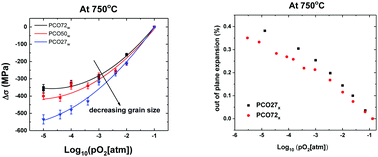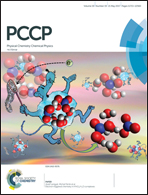Role of grain size on redox induced compositional stresses in Pr doped ceria thin films
Abstract
In constrained geometries and in varying oxygen partial pressures and operating temperatures, exchange of oxygen ions between non-stoichiometric oxide thin films (for example, doped and undoped ceria systems) and the gas phase can lead to stresses. In this study, these compositional stresses were investigated in thin films of nanocrystalline 10% praseodymium doped ceria (PCO), as a function of average grain size. In situ wafer curvature measurements, along with High Temperature X-Ray Diffraction (HTXRD), were employed to measure stresses and strains, respectively on the PCO films during oxidation–reduction cycling, over the pO2 range of 10−1–10−5 atm at 750 °C. For relatively large grain sizes, the stress values agree well with the amount of expansion induced by oxygen non-stoichiometry (chemical expansion) predicted by a thin film defect equilibria model that was developed previously. The compositional stresses were found to increase with decreasing grain size. The origin of this effect, including the role of space charge effects near surfaces and interfaces are discussed in this paper. To our knowledge, this is the first time that such comparisons are reported by simultaneously employing high temperature in situ wafer curvature and HTXRD measurements on doped ceria systems.



 Please wait while we load your content...
Please wait while we load your content...